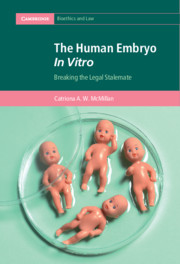Book contents
- The Human Embryo In Vitro
- Cambridge Bioethics and Law
- The Human Embryo In Vitro
- Copyright page
- Dedication
- Contents
- Foreword
- Acknowledgements
- Table of Cases
- Table of Legislation
- Abbreviations
- Introduction
- Part I Into Liminality
- Part II Through Liminality
- Part III Out of Liminality
- 6 A Context-Based Approach
- 7 Looking Forward
- Conclusion
- Bibliography
- Index
6 - A Context-Based Approach
from Part III - Out of Liminality
Published online by Cambridge University Press: 18 March 2021
- The Human Embryo In Vitro
- Cambridge Bioethics and Law
- The Human Embryo In Vitro
- Copyright page
- Dedication
- Contents
- Foreword
- Acknowledgements
- Table of Cases
- Table of Legislation
- Abbreviations
- Introduction
- Part I Into Liminality
- Part II Through Liminality
- Part III Out of Liminality
- 6 A Context-Based Approach
- 7 Looking Forward
- Conclusion
- Bibliography
- Index
Summary
The analysis in this chapter emphasises that there can only ever be two places that law, in its present state, can lead embryos to: a woman’s womb, or its own destruction and disposal. Ultimately, this chapter has been developed with a view to answering: how might we use a liminal lens to bring lessons from ‘the gothic’, from conceptualisation to realisation? This chapter addresses the latter in four sections. First, it briefly takes stock of the analysis and ‘lessons’ highlighted by the book so far, before going on to synthesise this analysis, and in doing so, considering the ways in which law can lead embryos out of liminality. Second, it focuses on the roles of persons in embryonic processes in vitro; and Third, it draws out the contours of a context-based approach, including what the approach is not; Finally, it, discusses the potential effects of a context-based approach for the issues (i.e. the contours of the ‘legal gap’) discussed in Part One of this book. It suggests that a context-based approach has the potential to justify affording embryos in vitro different ‘statuses’ depending on the relationally guided and defined pathway on which it is, or onto which it is put.
Keywords
Information
- Type
- Chapter
- Information
- The Human Embryo In VitroBreaking the Legal Stalemate, pp. 151 - 177Publisher: Cambridge University PressPrint publication year: 2021
